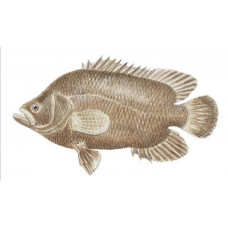Latin name
Lobotes surinamensis
Other names
Atlantic tripletail, brown tripletail, dusky tripletail, sleepfish, buoy fish, buoy bass, chobie, triplefin, flasher; Afrikaans: driestert; Bengali: samudra koi; French: croupia roche; Japanese: matsudai; Malay/Indonesian: ikan tidur, kakapbato, pelayak, sekusong; Portuguese: furriel, prejereba; Spanish: dormilona.
Identification
Tripletail is characterized by rounded dorsal and anal fins that extend backward along the caudal outgrowth, giving the impression that the fish has a three-bladed, or triple-tailed, tail. It has a deep, compressed body, resembling that of a freshwater crappie, and a concave profile. The eyes are far forward on the snout, and the edge of the preopercle is strongly serrated. Compared to other marine fish, the tripletail is most similar to the grouper, but it lacks teeth on the roof of its mouth. The coloration is sparse, varying in shades from yellow-brown to dark brown, with indistinct spots and specks on the sides.
Distribution
Inhabiting tropical and subtropical waters of all oceans, they occur in the western Atlantic from Massachusetts and Bermuda to Argentina. In the eastern Pacific, they are found from Costa Rica to Peru.
Habitat
Tripletail are found in coastal waters and enter muddy estuaries, usually in depths of up to 20 feet. There is some suggestion of a northern and coastal migration to warmer waters in spring and summer.
Size
Tripletail can reach lengths of 31⁄2 feet and weights of up to 50 pounds, although individuals 11⁄2 to 21⁄2 feet long and weighing less than 20 pounds are more common. The world record set for all gears is 42 pounds, 5 ounces. The fish can live anywhere from 7 to 10 years.
Life history and Behavior
Although little is known about their spawning behavior, the triplet is thought to become sexually mature by the end of their first year of life. Spawning occurs in spring and summer, and although some fish may move to coastal areas to spawn, young fish have been found in estuaries and in coastal sargassum thickets. Tripletail swim on their sides in the company of other floating objects.
Food and feeding habits
Tripletail feeds almost exclusively on other fish such as herring, menhaden and anchovies, as well as eels and benthic crustaceans such as shrimp, crabs, and squid.
Reproduction
No information
| Classification | |
| Phylum | Chordata |
| Class | Actinopterygii |
| Squad | Perciformes |
| Family | Lobotidae |
| Genus | Lobotes |
| Species | L. surinamensis |
| Features | |
| Conservation status | Least Concern |
| Habitat | Littoral |
| Life span, years | No information |
| Maximum body weight, kg | 18 |
| Maximum length, cm | 90 |
| Sailing speed, m/s | No information |
| Threat to people | Edible |
| Way of eating | Predator |
Tripletail
Tags: Tripletail



